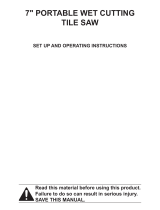
Page 5For technical questions, please call 1-888-866-5797.Item 69231
SAFETYOPERATIONMAINTENANCE SETUP
d. Freehand – Feeding a workpiece through the
saw without using a fence or guided support
to guide it. NOT A SAFE METHOD.
e. Kerf – The gap made by the saw in the workpiece.
f. Kickback – A sudden reaction to a pinched,
bound, or misaligned blade, causing
an uncontrolled workpiece to lift up and
out of the saw toward the operator.
g. Spreader – A metal plate that follows the
saw blade to keep the kerf (gap) from closing
on the saw blade. Spreaders, except riving
knives, must be aligned to the blade after
blade adjustment to prevent binding.
h. Riving Knife – A spreader mounted on the
same mechanism as the blade. Generally
more effective than simple spreaders.
11. As noted previously, Kickback is a sudden reaction
to a pinched, bound, or misaligned blade, causing an
uncontrolled workpiece to lift up and out of the saw
toward the operator.
Kickback is usually a result of tool misuse and can be
limited or avoided by following the precautions below:
• Fence must be completely
parallel to the saw blade.
• Workpiece must be free from flaws and from
foreign objects (such as nails and screws).
• Support large workpieces along their
entire length. Large workpieces tend
to bend, grabbing the blade.
• Do not use a dull or damaged blade.
• Maintain control of the workpiece. Do not
allow the workpiece to rest against the
moving blade without holding onto it.
• If the blade binds or a cut is interrupted, turn
off the power switch and hold the workpiece
still until the blade stops. Correct the cause
of blade binding before proceeding.
• Before continuing an unfinished cut, center
the blade in the pre-cut kerf and check that
the saw teeth are not engaged into the
workpiece before turning on the saw.
• Push the workpiece past the
blade prior to release.
12. Check the guard for proper operation with
saw disconnected from power before each
use. Do not disable any guard. Do not
operate saw if any movable guard does not
move freely and close instantly. Make sure
any movable guard does not touch the blade
in all angles, depths of cut, and positions.
13. Keep the guard in place while through-
sawing. Verify that the spreader lines up
with the blade to prevent binding.
14. Construct an appropriate Push Stick out of wood
according to the guidelines on the following page.
15. DO NOT OPERATE WITH ANY GUARD DISABLED,
DAMAGED, OR REMOVED. Moving guards
must move freely and close instantly.
16. The use of accessories or attachments not
recommended by the manufacturer may
result in a risk of injury to persons.
17. When servicing use only identical replacement parts.
18. Only use safety equipment that has been approved
by an appropriate standards agency. Unapproved
safety equipment may not provide adequate
protection. Eye protection must be ANSI-approved
and breathing protection must be NIOSH-approved
for the specific hazards in the work area.
19. Stay alert, watch what you are doing and use
common sense when operating a power tool.
Do not use a power tool while you are tired or
under the influence of drugs, alcohol or medication.
A moment of inattention while operating power
tools may result in serious personal injury.
20. Industrial applications must follow OSHA guidelines.
21. Maintain labels and nameplates on the tool.
These carry important safety information.
If unreadable or missing, contact
Harbor Freight Tools for a replacement.
22. Avoid unintentional starting.
Prepare to begin work before turning on the tool.
23. People with pacemakers should consult their
physician(s) before use. Electromagnetic fields in
close proximity to heart pacemaker could cause
pacemaker interference or pacemaker failure.
Tilesaw Safety Warnings (cont.)


















